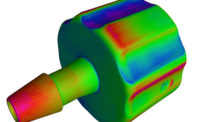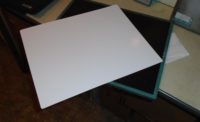The effects of manufacturing process parameters on structural strength, durability and damage tolerance are not well understood. In particular, the effects of inadequate design method and manufacturing process used to produce thick carbon/epoxy and glass/epoxy composite fatigue-critical, flight-critical components manifest themselves as defects such as wrinkles and porosity, and they impact the performance and the service life of these components. Such defects deteriorate the matrix-dominated properties resulting in degraded strength and fatigue structural behavior. Accurate measurements to quantify manufacturing defects are essential to establish the part condition and avoid assumptions of the worst-case scenario. As wrinkle geometry and porosity distributions in the fatigue-critical composite parts are three-dimensional, accurate 3-D measurement ability is required. The objective of this work is to show the ability of computed tomography (CT) for accurate three-dimensional measurement and characterization of defects in composite structures. Ability to measure wrinkles and porosity in thick structural details is demonstrated. Also, technology development requirements to convert the defect geometry data into finite element models for assessment of the effects of the defects are discussed.
MANUFACTURING ISSUES
Currently, composite designs adopt metal design philosophy and use the same factor of safety of 1.5 to determine the ultimate design load from the limit load even though composite parts are inherently more susceptible to variations in manufacturing processes than metal parts. In addition to material variation in the resin content, bulk factor, and fiber alignment, part fabrication process variations such as operator skill, tooling setup, humidity fluctuation, equipment control, etc. are common causes that contribute to variation in part quality. Consequently, the increased sensitivity of composite part quality to material and process variations lowers production yields. In order to increase production yields, heavy burden is placed on composite manufacturing communities to understand and control their processes. Production yields of greater than 90% remain a ‘hit-and-miss’ target.
It is worth noting that multiple defect types and their combinations contribute to structural failure. For example, lower curing pressure will reduce fiber waviness (wrinkles) but may also increase porosity. Test data generated at GaTech showed that when lower curing pressure was used to reduce wrinkles in thick IM7/8552 carbon/epoxy composites, they delaminated at three times lower than theoretically predicted failure load values when porosity was ignored. Figure 1 shows finite element-based failure model predictions and subsequent test correlation. Please note that failure loads, cycles to failure, and damage patterns measured in the similar test articles manufactured using higher curing pressure which increased the wrinkle severity but also eliminated the porosity issue matched the failure model predictions under static and fatigue loading conditions (Refs. 1-3). Although it might not be practical to eliminate all the defects in a composite part, it is possible to improve the part performance once the defects and their effects are captured and accounted for in the composite part design.
Wrinkles and porosity can severely limit the performance of the composite parts. Accurate measurements to quantify such flaws are essential to establish the part condition and avoid assumptions of the worst-case scenario. Condition-based utilization will enable lower scrap rates in the fatigue-critical composite parts. As wrinkle geometry and porosity distributions in the fatigue-critical composite parts are three-dimensional, accurate 3-D measurement ability is required. Such measurement must also be converted to finite element models for assessment of the effects of the defects.
MEASUREMENT TECHNIQUES
Computed tomography (CT) is a proven nondestructive evaluation (NDE) technology enabling accurate three-dimensional measurement of manufacturing defects including wrinkles and porosity. Figure 2 shows the operation basics for a modern industrial CT system.
Figure 2. Major components and operation principle for a modern industrial C T system.
The system uses three major components: an x-ray tube, x-ray detectors, and a rotational stage. New generation microfocus x-ray tubes and amorphous silicon flat panel area detectors offer micron-scale resolution which cannot be matched by the other NDE methods.
A CT scan typically includes a series of 2-D X-ray images of the object rotating 360 degrees (complete rotation) or 180 degrees (half rotation). CT systems acquire between 120 and 3600 digital images, the image size 3 to 10 megapixels, depending on the desired resolution. Once the scan is complete, CT reconstruction algorithms are used to generate the 3-D volumetric information. Due to recent advancement in the fast CT reconstruction software and computer hardware, the reconstruction process can be accelerated to a few minutes. It is possible to manipulate the volume in real time, e.g., slice anywhere inside the object, after the CT reconstruction.
A recent feasibility assessment demonstrated the ability to detect wrinkles and porosity in thick composites with a Micro-CT system.
Figures 3 & 8 show CT data for a 0.3-inch-thick glass/epoxy laminate with out-of-plane wrinkles and porosity/voids throughout the laminate thickness.
Figure 5. A C T slice shows porosity/voids and wrinkles.
Figure 3. C T data shows voids and wrinkles.
Figure 6. Voids and their surfaces.
Figure 7. Voids and their surfaces (zoom-in 1).
Figure 8. Voids and their surfaces (zoom-in 2).
The next test article is a 6-inch-wide and 4-inch-thick glass/epoxy composite yoke section. Figure 9 shows the density contour plot for the section. Figures 10 and 11 show a CT slice of the thick glass/epoxy yoke section to illustrate porosity defects in the composite structure. And Figure 12 shows another CT slice to illustrate wrinkle defects embedded in a thick glass/epoxy composite.
Figure 9. A CT image shows the density contour plot for a 6-inch-wide and 4-inch-thick glass/epoxy composite yoke section.
Figure 10. A CT slice of the glass/epoxy yoke structure shown in the previous Figure.
Figure 11. NSI VGStudio MAX CT software with porosity analysis module was used to determine the porosity distribution in the CT slice of the glass/epoxy yoke structure.
Figure 12. A CT slice of a thick glass/epoxy composite shows fiber-waviness.
Please note that 4-inch laminate thickness represents an extreme case of thick composites and fiberglass is more difficult to penetrate (higher density material) compared to carbon-reinforced composites.
Micro-CT might be the only available NDE technology with adequate resolution ability to accurately measure fiber waviness in composites. The density contrast between fibers and the matrix and between various plies within a composite laminate structure might not be large enough for other techniques. For example, ultrasound based methods work well for detection of air gaps such as delaminations but not regions with slight variations in the resin content. Micro-CT detects individual fiberbundles and therefore fiber-distorted plies can also be captured. Also, the ability to detect wrinkles using ultrasonic-based methods is likely to be limited to the first wrinkle encountered. Multiple wrinkles through the laminate thickness will likely be masked by the first wrinkle (closer to the nearest ultrasonic transducer) due to the signal scatter. Please note that the first wrinkle encountered is typically least severe. Ultrasound-based technology has yet to demonstrate its ability to accurately quantify the shape of small wrinkles embedded deep inside a thick glass/epoxy laminate as well as its ability to detect multiple wrinkles through the thickness.
It is worth noting that CT is also able to capture wrinkles which are close to the surface of a composite part. Figure 13 shows a fiberglass main rotor blade spar section near the root end. Although the wrinkles are located at the surface, wrinkle measurement conducted by visual inspection and aided by rudimentary measurement tools such as a ruler or a caliper could result in unacceptable measurement variation and affect the objectivity at making disposition decision of the affected part. Figure 13 shows that CT data provide high spatial resolution and high clarity wrinkle images essential for repeatable and reproducible in-plane and out-of-plane characterization.
Figure 13. CT data show the material structure and surface wrinkles for a fiberglass main rotor spar root section.
Although the industrial micro-CT system used in the feasibility assessment demonstrated that the micro-CT technology is well-suited for characterization of wrinkles and porosity in composites, including thick composite structures, the system configuration is not suitable for the inspection of long composite parts such as wing spars, rotor blades, yokes, flexbeams, etc. It is not possible to manipulate such parts in the CT scanner without high risk of deforming them. The parts must be stationary and the x-ray tube and detectors must move around the parts. Such arrangement is similar to the medical CT systems. Figure 14 shows major components and operation principle for a medical CT system. Medical CT scanners can handle long parts but the resolution of the medical CT technology is not adequate for characterization of wrinkles and porosity defects.
Limitations of medical CT are summarized in the following:
1. The maximum X-ray energy is too low (under 120kV) for penetration of thick composite parts. The reconstructed images are noisy and oftentimes the area of interested is invisible due to reconstruction artifacts.
2. The maximum resolution is limited. Medical scanners which are able to fit large composite parts can provide a 0.5 mm per pixel maximum resolution. Figure 14 shows that such resolution is not adequate for measurement of wrinkles in the composite parts.
A successful CT system for efficient and accurate measurement of wrinkles and porosity in large and thick composite parts must combine the industrial micro-CT resolution ability and the medical CT ability to scan large objects. Due to the latest advances in the industrial micro-CT technology, such system can be developed and its cost can be much lower compared to the medical CT scanners. And accurate measurement and characterization of wrinkles in composites must be fully-automated. Due to complex geometries, manual CT image assessment is time-consuming and unreliable and could result in unacceptable measurement variation affecting the part disposition.
Accurate defect measurements must also be converted into 3-D finite element-based failure models to assess the effects of the defects on structural performance. Coupling accurate measurements and rigorous failure models will improve overly conservative part rejection criteria and enable lower scrap rates in the flight-critical composite parts.
Key requirements for the nondestructive evaluation (NDE) technology are summarized in the following:
- Ability to measure wrinkles and porosity in large structures and thick parts such as spars and yokes. Wrinkles and porosity defects as well as their combinations contribute to structural failure. Ability to capture the shape of small wrinkles embedded deep inside a thick glass/epoxy structure as well as detect multiple wrinkles through the thickness must be included.
- Automated three-dimensional wrinkle characterization. Ability to generate accurate geometry data and convert the data into finite element models for assessment of effects of defects.
Such technology will enable the development of a commercial NDE system for accurate measurement and characterization of wrinkles and various defects in composite fatigue-critical components and structure.
MICRO-CT TECHNOLOGY DEVELOPMENT REQUIREMENTS
It is necessary to accomplish CT experiments focused on the detection and measurement of in-plane and out of-plane wrinkles in composite structures provided by the industry to develop a successful micro-CT technology optimized for accurate three-dimensional measurement of wrinkles (and combinations of multiple defects) in large structures and thick parts such as spars and yokes.
The CT experiments must utilize:
(a)Various X-ray sources with different energy capacity and multiple detector technologies with different pixel size, resolution and contrast sensitivities.
(b)Different scanning methods and algorithms such as fan-beam CT, helical fan-beam, cone-beam CT, to establish the optimum technique.
(c)Various focal distances (distance from x-ray source and x-ray detector) and the position of the part to be scanned.
(d)The scanning at different speed. The best CT scan reconstruction quality versus speed will be established.
CT reconstructions with scanning time, resolution and image quality information must be documented. The hardware requirements for a successful and affordable system must be established.
THREE-DIMENSIONAL WRINKLE CHARACTERIZATION
It is necessary to develop the ability to measure wrinkle geometry based on the analysis of CT data and convert the CT data into finite element models for assessment of the effects of defects. The software for recognition of three-dimensional manufacturing defect patterns and automated generation of the laminate structure finite element models which account for wrinkles and porosity must be built. Successful software must meet the following requirements:
(a)Ability to identify ply boundaries based on the CT data with variable resolution.
(b)Noise filtering that generates sufficiently smooth boundary surfaces from the CT data.
(c)Modeling of voids that will not overburden finite element (FE) models, yet achieve correct stress concentration levels.
The software must be calibrated and verified. FE packages that satisfy the requirements of the subsequent failure analysis must be identified.
Summary
A brief overview of manufacturing issues affecting structural performance of composite fatigue-critical, flight-critical parts is presented in this work. Feasibility of computed tomography (CT) for accurate nondestructive measurement of the manufacturing defects including wrinkles and porosity is illustrated. CT can become a powerful diagnostic tool and enable the subsequent ability to predict part capability and remaining useful life. Such abilities are required to enable the condition-based composite part utilization.
ACKNOWLEDGEMENTS
This effort is sponsored by the US Office of Naval Research. Such support is gratefully acknowledged.
BIBLIOGRAPHY AND REFERENCES
[1] Makeev, A., Seon, G., and Lee, E., Failure Predictions for Carbon/Epoxy Tape Laminates with Wavy Plies, Journal of Composite Materials, Vol. 44, 2010, pp. 95-112.
[2] Nikishkov, Y., and Makeev, A., Fatigue Damage Simulations in Composites, Proceedings of the American Helicopter Society 66th Annual Forum, Phoenix, AZ, May 11-13, 2010.
[3] Makeev, A., Nikishkov, Y., Seon, G., and Lee, E., Fatigue Structural Substantiation for Thick Composites, Proceedings of the 17th International Conference on Composite Materials, Edinburgh, UK , 2009.
[4] Nikishkov, Y., Makeev, A., and Seon, G., Finite Element-Based Simulations of Damage in Composites, Proceedings of the American Helicopter Society 65th Forum, Grapevine, Texas, 2009.
Presented at the American Helicopter Society 66th Annual Forum, Phoenix, AZ, May 11-13, 2010.

















